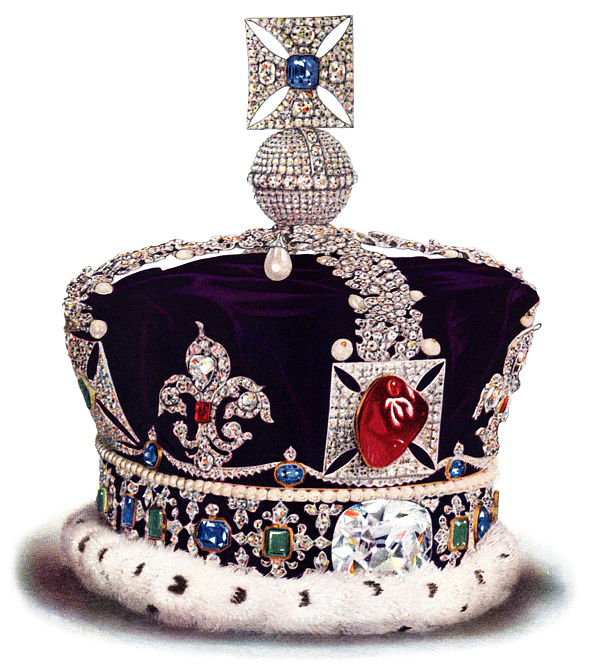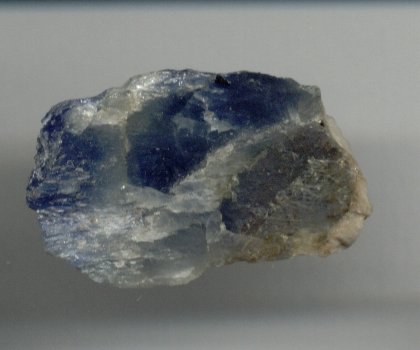|
Spinel
Spinel () is the magnesium/aluminium member of the larger spinel group of minerals. It has the formula in the cubic crystal system. Its name comes from the Latin word , a diminutive form of ''spine,'' in reference to its pointed crystals. Properties Spinel crystallizes in the isometric system; common crystal forms are octahedron, octahedra, usually Crystal twinning, twinned. It has no true Cleavage (crystal), cleavage, but shows an octahedral Parting (crystal), parting and a conchoidal fracture. Its Mohs scale of mineral hardness, hardness is 8, its specific gravity is 3.5–4.1, and it is transparent to opaque with a vitreous to dull Lustre (mineralogy), luster. It may be colorless, but is usually various shades of red, lavender (color), lavender, blue, green, brown, black, or yellow. Chromium(III) causes the red color in spinel from Burma. Some spinels are among the most famous gemstones; among them are the Black Prince's Ruby and the "Timur ruby" in the British Crown Jewels ... [...More Info...] [...Related Items...] OR: [Wikipedia] [Google] [Baidu] |
Spinel Group
The spinels are any of a class of minerals of general formulation which crystallise in the cubic (isometric) crystal system, with the X anions (typically chalcogens, like oxygen and sulfur) arranged in a cubic close-packed lattice and the cations A and B occupying some or all of the octahedral and tetrahedral sites in the lattice.H-J MeyerFestkörperchemiein: H-J Meyer (ed.), ''Riedel Moderne Anorganische Chemie'', Walter de Gruyter, 2012, . Retrieved 15 April 2018. Although the charges of A and B in the prototypical spinel structure are +2 and +3, respectively (), other combinations incorporating divalent, trivalent, or tetravalent cations, including magnesium, zinc, iron, manganese, aluminium, chromium, titanium, and silicon, are also possible. The anion is normally oxygen; when other chalcogenides constitute the anion sublattice the structure is referred to as a thiospinel. A and B can also be the same metal with different valences, as is the case with magnetite, (as ), which ... [...More Info...] [...Related Items...] OR: [Wikipedia] [Google] [Baidu] |
Black Prince's Ruby
The Black Prince's Ruby is a large, irregular cabochon red spinel weighing set in the cross pattée above the Cullinan II diamond at the front of the Imperial State Crown of the United Kingdom. The spinel is one of the oldest gems in the Crown Jewels of the United Kingdom, with a history dating back to the mid-14th century. According to a legend originating from the 1760s, the stone has been in the possession of the English and later British monarchy since it was given in 1367 by the Spanish king Peter of Castile to the then Prince of Wales, Edward of Woodstock, known as the "Black Prince". Henry V is said to have worn it at the Battle of Agincourt in 1415. The stone is believed to have been mined in Badakhshan in present day Afghanistan, the principal source of large spinel gems in the Middle Ages. Spinel The Black Prince's Ruby weighs and is approximately long.Ogden, p. 361. All red gemstones used to be referred to as rubies or "balas rubies". It was not u ... [...More Info...] [...Related Items...] OR: [Wikipedia] [Google] [Baidu] |
Crown Jewels Of The United Kingdom
The Crown Jewels of the United Kingdom, originally the Crown Jewels of England, are a collection of royal ceremonial objects kept in the Jewel House at the Tower of London, which include the coronation regalia and vestments worn by British monarchs. The coronation regalia are the only working set in Europe and the collection is the most historically complete of any royal regalia in the world. Objects used at the coronation ceremony variously denote the monarch's roles as head of state of the United Kingdom, Supreme Governor of the Church of England, and head of the British armed forces. The regalia feature heraldic devices and national emblems of England, Scotland, Wales, Northern Ireland, and other Commonwealth countries. Use of regalia by monarchs in England can be traced back to when the country was converted to Christianity in the Early Middle Ages. A permanent set of coronation regalia, once belonging to Edward the Confessor, was established after he was made a saint in ... [...More Info...] [...Related Items...] OR: [Wikipedia] [Google] [Baidu] |
Timur Ruby
The Timur Ruby (also ''Khiraj-i-alam'', "Tribute to the World") is an unfaceted, polished red spinel set in a necklace. It is named after the ruler Timur,Morgan, Diane (2008). ''Fire and Blood: Rubies in Myth, Magic, and History.'' Greenwood Publishing Group, founder of the Timurid Empire and purportedly one of its former owners. It was believed to be a ruby until 1851. It is inscribed with the titles of five of its previous owners: Jahangir (who also had the name of his father Akbar the Great inscribed), Shah Jahan, Farrukhsiyar, Nader Shah and Ahmad Shah Durrani.Ball V. (1894)A Description of Two Large Spinel Rubies, with Persian Characters Engraved upon Them.'' Proceedings of the Royal Irish Academy'' Vol. 3, (1893–1896), pp. 380–400 Since 1612, the owners of the Timur ruby have also owned the Koh-i-Noor diamond. It has been in the possessions of the Safavid, Mughal, Sikh and British empires, and is currently part of the Royal Collection. History Origins Spinels ... [...More Info...] [...Related Items...] OR: [Wikipedia] [Google] [Baidu] |
Crystal Twinning
Crystal twinning occurs when two or more adjacent crystals of the same mineral are oriented so that they share some of the same crystal lattice points in a symmetrical manner. The result is an intergrowth of two separate crystals that are tightly bonded to each other. The surface along which the lattice points are shared in twinned crystals is called a composition surface or twin plane. Crystallographers classify twinned crystals by a number of twin laws, which are specific to the crystal structure. The type of twinning can be a diagnostic tool in mineral identification. There are three main types of twinning. The first is growth twinning which can occur both in very large and very small particles. The second is transformation twinning, where there is a change in the crystal structure. The third is deformation twinning, in which twinning develops in a crystal in response to a shear stress, and is an important mechanism for permanent shape changes in a crystal. Definition T ... [...More Info...] [...Related Items...] OR: [Wikipedia] [Google] [Baidu] |
Oxide Minerals
The oxide mineral class includes those minerals in which the oxide anion (O2−) is bonded to one or more metal alloys. The hydroxide-bearing minerals are typically included in the oxide class. Minerals with complex anion groups such as the Silicate mineral, silicates, Sulfate mineral, sulfates, carbonate mineral, carbonates and Phosphate mineral, phosphates are classed separately. Simple oxides *XO form **Periclase group ***Periclase ***Manganosite **Zincite group ***Zincite ***Bromellite ***Tenorite ***Litharge * form **Cuprite **Ice * form **Hematite group ***Corundum ***Hematite ***Ilmenite * form **Rutile group ***Rutile ***Pyrolusite ***Cassiterite **Baddeleyite **Uraninite **Thorianite * form **Spinel group ***Spinel ***Gahnite ***Magnetite ***Franklinite ***Chromite **Chrysoberyl **Columbite *Hydroxide subgroup: **Brucite **Manganite **Romanèchite **Goethite group: ***Diaspore ***Goethite Nickel–Strunz class 4: oxides Internationa ... [...More Info...] [...Related Items...] OR: [Wikipedia] [Google] [Baidu] |
Aluminium
Aluminium (or aluminum in North American English) is a chemical element; it has chemical symbol, symbol Al and atomic number 13. It has a density lower than that of other common metals, about one-third that of steel. Aluminium has a great affinity towards oxygen, passivation (chemistry), forming a protective layer of aluminium oxide, oxide on the surface when exposed to air. It visually resembles silver, both in its color and in its great ability to reflect light. It is soft, magnetism, nonmagnetic, and ductility, ductile. It has one stable isotope, 27Al, which is highly abundant, making aluminium the abundance of the chemical elements, 12th-most abundant element in the universe. The radioactive decay, radioactivity of aluminium-26, 26Al leads to it being used in radiometric dating. Chemically, aluminium is a post-transition metal in the boron group; as is common for the group, aluminium forms compounds primarily in the +3 oxidation state. The aluminium cation Al3+ ... [...More Info...] [...Related Items...] OR: [Wikipedia] [Google] [Baidu] |
Lustre (mineralogy)
Lustre (Commonwealth English) or luster (American English; see spelling differences) is the way light interacts with the surface of a crystal, rock, or mineral. The word traces its origins back to the Latin ''lux'', meaning "light", and generally implies radiance, gloss, or brilliance. A range of terms are used to describe lustre, such as ''earthy'', ''metallic'', ''greasy'', and ''silky''. Similarly, the term ''vitreous'' (derived from the Latin for glass, ''vitrum'') refers to a glassy lustre. A list of these terms is given below. Lustre varies over a wide continuum, and so there are no rigid boundaries between the different types of lustre. (For this reason, different sources can often describe the same mineral differently. This ambiguity is further complicated by lustre's ability to vary widely within a particular mineral species). The terms are frequently combined to describe intermediate types of lustre (for example, a "vitreous greasy" lustre). Some minerals exhib ... [...More Info...] [...Related Items...] OR: [Wikipedia] [Google] [Baidu] |
Badakhshan
Badakhshan is a historical region comprising the Wakhan Corridor in northeast Afghanistan, eastern Tajikistan, and Taxkorgan Tajik Autonomous County in China. Badakhshan Province is one of the 34 provinces of Afghanistan. Much of historic Badakhshan lies within Tajikistan's Gorno-Badakhshan Autonomous Region in the southeastern part of the country. The music of Badakhshan is an important part of the region's cultural heritage. Name The name "Badakhshan" (, ''Badaxšân''; ; , ''Badakhshon''; ) is derived from the Sasanian official title ''bēdaxš'' or ''badaxš'', which may be from an earlier *pati-axša; the suffix -''ān'' indicates that the country belonged, or had been assigned as a fief, to a person holding the rank of a '' badaxš''. People Badakhshan has a diverse ethnolinguistic and religious community of Badakhshanites. Tajiks and Pamiris are in the majority while a tiny minority of Kyrgyzs, Uzbeks, Hazaras, and Pashtuns are also found in some villages. ... [...More Info...] [...Related Items...] OR: [Wikipedia] [Google] [Baidu] |
Corundum
Corundum is a crystalline form of aluminium oxide () typically containing traces of iron, titanium, vanadium, and chromium. It is a rock (geology), rock-forming mineral. It is a naturally transparency and translucency, transparent material, but can have different colors depending on the presence of transition metal impurities in its crystalline structure. Corundum has two primary gemstone, gem varieties: ruby and sapphire. Rubies are red due to the presence of chromium, and sapphires exhibit a range of colors depending on what transition metal is present. A rare type of sapphire, Sapphire#Padparadscha, padparadscha sapphire, is pink-orange. The name "corundum" is derived from the Tamil language, Tamil-Dravidian languages, Dravidian word ''kurundam'' (ruby-sapphire) (appearing in Sanskrit as ''kuruvinda''). Because of corundum's hardness (pure corundum is defined to have 9.0 on the Mohs scale), it can scratch almost all other minerals. Emery (rock), Emery, a variety of corundum w ... [...More Info...] [...Related Items...] OR: [Wikipedia] [Google] [Baidu] |






